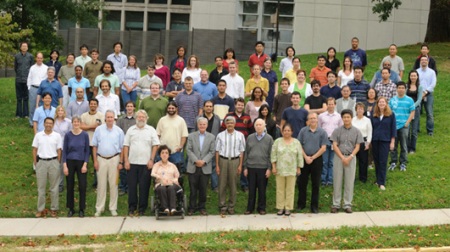Our Science – LCB Website
Laboratory of Cell Biology

|
| In addition to the information presented below, the LCB has an alternative website that can provide you with more detail about their work. |
Research
The Laboratory of Cell Biology studies the processing, transport, and metabolism of proteins and small molecules related to malignant transformation and multidrug resistance in cancer. Nine principal investigators expert in molecular biology, genetics, biochemistry, structural biology, and cellular regulation of cell growth and metabolism, resistance to anticancer drugs, antigen processing, and pigment formation work research projects related to regulation of cell growth and metabolism, the structure of membrane proteins, proteases and protein complexes, resistance to anticancer drugs, and pigment formation. The laboratory has seven sections: the Molecular Cell Genetics Section has units focusing on the molecular basis of anticancer drug resistance and the biochemistry of energy-dependent transporters; the Pigment Cell Biology Section studies mechanisms involved in regulation of melanin synthesis; the Chemical Immunology Section studies antigen presentation and the role of p53 in cell cycle regulation; the Biochemistry of Proteins Section studies the role of ATP-dependent proteolysis in multiple cellular processes; the Molecular Tumor Biology Section studies the regulation of cell division; the Biophysics Section develops novel EM-based approaches to determine single molecule and multisubunit structures. Two other units work on x-ray and EM crystallography of proteins and protein complexes. Joint journal clubs, data presentations, and research seminars ensure sharing of expertise and extensive collaborations among members of this laboratory.
Current work in the laboratory is based on significant recent contributions it has made regarding important cellular processes involved in development, prevention, or treatment of cancer. For example, the multidrug transporter, an energy-dependent efflux pump (ABC transporter) for many different cytotoxic chemotherapeutic drugs that contributes to drug resistance of approximately half of all human cancers, was cloned and characterized in the laboratory and new ABC transporters involved in drug resistance have been discovered. Two bacterial ATP-dependent proteases, LON and CLP, which have mammalian mitochondrial homologs, have been characterized and shown to share structural and catalytic features with mammalian proteosomes that are responsible for energy-dependent regulation of proteolysis in mammalian cells. The alternate metabolic pathways involved in melanin biosynthesis, a natural pigment protectant against UV-related DNA damage, have been defined. The structural requirements for binding of peptides to class I and class II major histocompatibility complex (MHC) molecules have been determined, and the information is being applied to the production of anticancer vaccines. Structural analysis of membrane proteins and protein complexes has been advanced using both x-ray and high resolution EM approaches.
This page was last updated on 9/17/2008.

